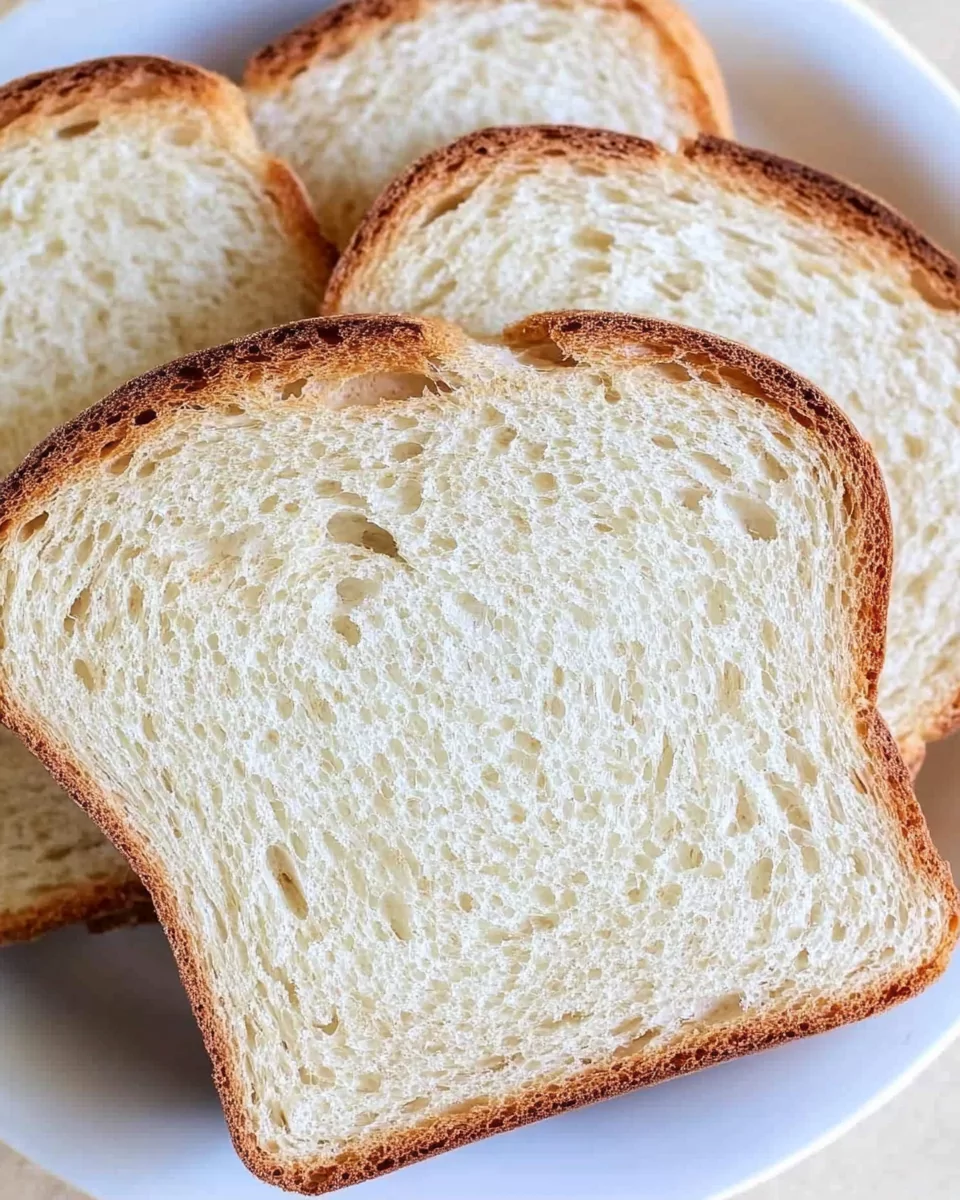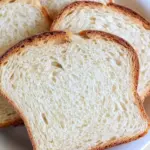Soft, fluffy, and slightly tangy, this sourdough discard sandwich bread is the ultimate quick bread recipe. It’s perfect for using up sourdough discard, requires minimal effort, and delivers two beautifully baked loaves in just a few hours. Whether you’re a beginner baker or a seasoned sourdough enthusiast, this recipe is a go-to for fresh, homemade bread without the long fermentation process.

This recipe stands out for its simplicity and quick preparation time. You’ll love the light texture, slightly tangy flavor, and the satisfaction of baking your own bread in just a few hours.
Why You’ll Love This Recipe
- Quick and Easy: Ready in a little over three hours, including rising and baking time.
- No Waste: A fantastic way to use up sourdough discard instead of throwing it away.
- Diet-Friendly: Dairy-free and refined sugar-free, suitable for various dietary needs.
- Soft and Versatile: Perfect for sandwiches, toast, or snacking plain.
- Beginner-Friendly: Simple instructions and no special skills required.
Preparation Phase & Tools
Essential Tools and Equipment
- Mixing Bowls: For combining wet and dry ingredients.
- Stand Mixer with Dough Hook: To make kneading effortless.
- Kitchen Scale: For accurate measurements, ensuring consistent results.
- Tea Towel or Plastic Wrap: To cover dough during rising phases.
- 9×5-inch Loaf Pans: For shaping and baking the loaves.
- Thermometer: To check the bread’s internal temperature for perfect doneness.
Importance of Each Tool
- Mixing Bowls: Allow space for mixing and rising the dough.
- Stand Mixer: Reduces manual labor, especially during the kneading stage.
- Kitchen Scale: Helps achieve precise ingredient ratios for best results.
- Loaf Pans: Provide structure and ensure uniform, even baking.
- Thermometer: Guarantees your bread is fully cooked without drying out.
Preparation Tips
- Warm Water is Key: Use water at 105–110°F to activate the yeast effectively.
- Room-Temperature Discard: Ensures smooth mixing and even dough hydration.
- Check Yeast Freshness: Ensure your yeast foams during activation. If not, replace it.
- Grease the Loaf Pans Well: Prevents sticking and makes for easier loaf removal.
Ingredients
Wet Ingredients
- 180g (¾ cup) warm water
- 7g (2 ¼ tsp) active dry yeast
- 60g (¼ cup) honey
- 180g (¾ cup) sourdough discard
- 60g (¼ cup) olive oil
Dry Ingredients
- 120g (1 cup) whole wheat flour
- 343g (2 ½ cups) bread flour
- 10g (1 ½ tsp) salt
Step-by-Step Directions
1. Activate the Yeast
- Combine warm water, honey, and active dry yeast in a mixing bowl.
- Let the mixture sit for 5 minutes until bubbly and foamy. This confirms that the yeast is alive and active.
2. Mix the Dough
- Add sourdough discard, olive oil, and the dry ingredients (whole wheat flour, bread flour, salt).
- Knead for 15 minutes using a stand mixer with a dough hook or by hand. The dough should feel smooth and elastic.
- Test gluten development with the windowpane test: Stretch a small piece of dough to see if it becomes thin and translucent without tearing. If it tears, knead for a few more minutes.
3. First Rise
- Shape the dough into a ball and place it in a greased bowl. Cover with a tea towel or plastic wrap.
- Let it rise in a warm, draft-free spot (about 80°F/27°C) for 40 minutes, or until doubled in size.
4. Shape the Loaves
- Punch down the risen dough and turn it onto a lightly floured surface.
- Divide the dough into two equal portions.
- Shape the loaves: Flatten each piece into a rectangle. Fold the top third down, fold the sides inward, and roll into a log. Pinch the seams to seal.
5. Second Rise
- Place the shaped dough seam-side down into two greased 9×5-inch loaf pans.
- Cover loosely and let the dough rise for 30 minutes to 1 hour, until it doubles in size and rises above the pan edges.
6. Bake
- Preheat the oven to 350°F (177°C).
- Bake for 35–40 minutes, or until the bread’s internal temperature reaches 190°F (88°C).
- Remove the loaves from the pans and cool on a wire rack. For a softer crust, brush the tops with olive oil while warm.
This sourdough discard sandwich bread is incredibly versatile and works well with various dishes and spreads. Below are some ideas to serve and elevate your freshly baked bread.
Serving Suggestions
1. Classic Sandwiches
- Use this bread as the base for deli sandwiches, PB&J, or grilled cheese.
- Its soft yet sturdy texture holds up well to a variety of fillings.
2. Toasted with Spreads
- Toast slices and top with butter, jam, or honey for a simple and satisfying snack.
- Pair with avocado, a sprinkle of salt, and red pepper flakes for a trendy avocado toast.
3. Accompaniments for Soups and Salads
- Serve alongside creamy soups like tomato, pumpkin, or potato leek.
- Use it to make croutons for Caesar or garden salads.
4. French Toast or Bread Pudding
- This bread’s slight tang and soft texture make it ideal for transforming into French toast or a rich bread pudding.
Common Mistakes to Avoid & How to Perfect the Recipe
- Skipping Yeast Activation: Always confirm your yeast is active (it should foam) before proceeding.
- Over or Under-Kneading: Knead just enough to pass the windowpane test. Over-kneading can make the dough too tough, while under-kneading prevents proper gluten formation.
- Ignoring Dough Temperature: Maintain a warm environment (around 80°F/27°C) for optimal rising. Cooler temperatures slow the rise, while excessive heat can kill the yeast.
- Improper Measuring: Use a kitchen scale for precise measurements. Inaccurate ratios can lead to dense or overly sticky bread.
- Overproofing During the Second Rise: Allow the dough to rise just until it doubles in size. Overproofing can cause the bread to collapse during baking.
- Skipping the Thermometer Check: Ensure the bread reaches an internal temperature of 190°F (88°C) for proper doneness.
Side Dish Recommendations
1. Garlic Herb Butter Spread
Create a simple herb butter to slather on slices. Combine softened butter with minced garlic, parsley, and a pinch of salt for an elevated flavor.
2. Homemade Hummus
Pair with creamy hummus for a light and healthy snack. Flavors like roasted red pepper or garlic complement the bread’s tanginess.
3. Avocado Salad
Serve alongside a fresh avocado salad with lime dressing for a refreshing, healthy combo.
4. Tomato Basil Soup
A classic pairing for toasted slices, creating a warm and comforting meal.
5. Cheese Board
Use this bread as a base for a charcuterie board with a selection of cheeses, meats, and fruits.
6. Egg Salad or Tuna Salad
Top slices with creamy egg or tuna salad for a satisfying lunch.
7. Vegetable Curry
Serve with a mild curry, using the bread to scoop up flavorful bites.
8. Caprese Salad
Complement the bread’s tanginess with a salad of tomatoes, fresh mozzarella, basil, and balsamic glaze.
Recipe Tips
1. Achieving the Perfect Texture
- Weigh Ingredients: Use a kitchen scale for precise measurements.
- Knead Thoroughly: Pass the windowpane test to ensure gluten is developed.
- Check Dough Consistency: If the dough feels too sticky, add a tablespoon of bread flour at a time. If it’s too dry, add a teaspoon of water.
2. Customization Options
- Add Seeds: Mix sesame, sunflower, or poppy seeds into the dough or sprinkle them on top before baking.
- Incorporate Herbs: Add dried herbs like rosemary, thyme, or oregano for a savory twist.
- Use Sweet Variations: Add cinnamon and raisins for a sweet loaf.
3. Timing Adjustments
- Rising times may vary based on kitchen temperature. Use a warm spot (e.g., near a preheated oven) for consistent results.
Storage and Reheating Instructions
Short-Term Storage
- Room Temperature: Keep in an airtight container or bag for up to 4 days.
- Reheat: Toast slices for a few minutes to restore softness and flavor.
Freezing Instructions
- Whole Loaf: Wrap tightly in plastic wrap and place in a freezer-safe bag. Freeze for up to 3 months.
- Individual Slices: Separate slices with parchment paper before freezing for easy thawing.
Thawing and Reheating
- Thaw: Let the loaf or slices sit at room temperature for a few hours.
- Reheat: Warm in the oven at 300°F (150°C) for 10–15 minutes or toast slices directly.
Frequently Asked Questions (FAQs)
1. Can I use sourdough discard that’s been refrigerated?
Yes! Let the discard come to room temperature before mixing it into the dough for even incorporation.
2. What if my dough doesn’t rise?
- Ensure your yeast is active.
- Check the rising environment; it should be warm (around 80°F/27°C).
- If the yeast is expired, the dough won’t rise properly.
3. Can I substitute the honey?
Yes, you can use maple syrup or agave syrup for a refined sugar-free alternative.
4. Why is my bread dense?
Dense bread can result from under-kneading, insufficient rising time, or incorrect flour-to-water ratios. Use the windowpane test and measure ingredients carefully.
5. Can I make this bread gluten-free?
This recipe is designed for wheat-based flours, and substituting with gluten-free flours will require significant adjustments.
6. What type of sourdough discard works best?
Unfed sourdough discard is ideal. Avoid using discard with added salt or other flavorings.
7. Can I bake this bread in one larger loaf pan?
Yes, but adjust the baking time to about 45–50 minutes and ensure the internal temperature reaches 190°F (88°C).
8. How do I get a softer crust?
Brush the top of the loaf with olive oil or melted butter immediately after baking.
Conclusion
This sourdough discard sandwich bread is a beginner-friendly recipe that delivers soft, flavorful loaves perfect for any occasion. Whether you’re using it for sandwiches, toast, or as a base for creative dishes, this bread is versatile and satisfying. With its quick rise times and simple preparation, it’s an easy way to enjoy homemade bread while making good use of your sourdough discard.
Make a batch today and enjoy the aroma of freshly baked bread filling your kitchen! 🥖
The Easiest Sourdough Discard Sandwich Bread
Ingredients
Wet Ingredients:
- 180 g ¾ cup warm water
- 7 g 2 ¼ tsp active dry yeast
- 60 g ¼ cup honey
- 180 g ¾ cup sourdough discard
- 60 g ¼ cup olive oil
Dry Ingredients:
- 120 g 1 cup whole wheat flour
- 343 g 2 ½ cups bread flour
- 10 g 1 ½ tsp salt
Instructions
Activate the Yeast
- In a large mixing bowl or the bowl of a stand mixer, combine the warm water, honey, and yeast.
- Let it sit for 5 minutes until bubbly to ensure the yeast is activated.
Mix the Dough
- Add the sourdough discard, olive oil, and all remaining dry ingredients to the bowl.
- Knead the mixture for 15 minutes using the dough hook attachment of a stand mixer or by hand.
- Perform the “windowpane test” by stretching a small section of dough until it is thin enough to see light through it. If the dough tears, knead for a few more minutes, up to a total of 20 minutes.
First Rise
- Shape the dough into a ball and place it in a large bowl. Cover with a tea towel and let it rise in a warm place. If the dough stays above 80°F (27°C), the rise will take about 40 minutes.
- Allow the dough to double in size.
Shape the Loaves
- Punch down the risen dough and place it on a lightly floured surface. Divide it into 2 equal portions.
- Shape each portion by gently pulling it into a rectangle. Fold the top third down, then fold the sides in toward the center. Roll the dough into a log and pinch the seams to seal. Alternatively, roll the dough out into a rectangle the length of your loaf pan, roll it up like a log, and pinch the seams.
- Place the shaped dough seam-side down into two greased 9×5-inch loaf pans.
Second Rise
- Cover the pans loosely and let the dough rise for 30 minutes to 1 hour, or until it doubles in size and rises above the sides of the pans.
Bake
- Preheat your oven to 350°F (177°C).
- Bake the loaves for 35–40 minutes, or until the internal temperature of the bread reaches 190°F (88°C).
- Remove the loaves from the pans and let them cool on a wire rack. For a softer crust, brush the tops with olive oil while the bread is still warm.
Notes
Storage: Store in an airtight bag or container for up to 4 days, or freeze for up to 3 months.
Rising Time: Rising times may vary depending on the temperature of your kitchen. Keep dough in a warm spot to speed up fermentation.




With just a total of 3 1/2 cups of flour, would this really make 2-9×5 loaves?? Also, has anyone tried mixing & kneading or making the whole thing in their breadmachine??
It’s enough for two loaves! a bread machine works well for kneading, but I recommend baking in the oven for the best texture.
Oh my goodness! We made this a couple of times and loved it…my husband raved about it and then I lost the page with the recipe…( Then after searching everywhere I thought that I’d been-I thought to check my computer history and there it was!!!Recipe printed for the file and saved on my computer and on my backup drive now. This was the easiest bread that I have ever made , with simple instructions and information and I am really thankful we found it. Today I have hamburger and hot dog buns proofing and the house again smells like heaven. Thank you for sharing.
That’s amazing! I’m so glad you found the recipe again and that it’s become a favorite in your home. Your kitchen must smell incredible with those buns proofing! Thank you for your kind words and for sharing your experience. Happy baking!